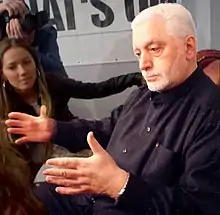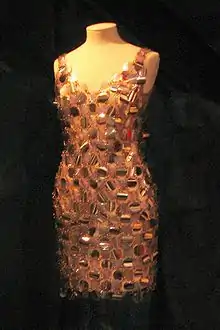Paco Rabanne
Francisco Rabaneda Cuervo (born 18 February 1934), more commonly known under the pseudonym of Paco Rabanne (French: [pako ʁaban]; Spanish: [ˈpako raˈβan]), is a Spanish[1] fashion designer of Basque origin who became known as an enfant terrible of the 1960s French fashion world.
Paco Rabanne | |
|---|---|
 Rabanne in Kyiv, 2006 | |
| Born | Francisco Rabaneda Cuervo 18 February 1934 Pasajes, Guipuzkoa, Basque Country |
| Occupation | Fashion designer |
Early life and education
Rabanne was born 18 February 1934 in the Basque town of Pasajes, Gipuzkoa province. His father, a Republican Colonel, was executed by Francoist troops during the Spanish Civil War. Rabanne's mother was chief seamstress at Cristóbal Balenciaga's first couture house in Donostia, Basque Country, and moved Rabanne's family when he opened Balenciaga at Paris in 1937, due to the Spanish Civil War. In mid-1950s Paris, while studying architecture at l'École Nationale des Beaux-Arts, Rabanne earned money making fashion sketches for Dior and Givenchy, and shoe sketches for Charles Jourdan, nevertheless he subsequently took a job with France's foremost developer of reinforced concrete, August Peret, working there for over ten years.[2]
Career
Fashion


He started his career in fashion by creating jewelry for Givenchy, Dior, and Balenciaga and founded his own fashion house in 1966.[3] He used unconventional material such as metal, paper, and plastic for his metal couture and outlandish and flamboyant designs.[4]
For the debut of his namesake brand in 1966, he presented "Manifesto: 12 unwearable dresses in contemporary materials".[1]
Rabanne is known for the green costume worn by Jane Fonda in the 1968 science-fiction film Barbarella. Françoise Hardy was a big fan of Rabanne's designs.[5] For fr:Tour 1996 and the resulting Live à Bercy, singer Mylène Farmer had Rabanne do her live-concert stage costumes.[6][7][8][9]
Fragrance
In 1968, he began collaborating with fragrance[10] company Puig, which resulted in the company marketing Rabanne's perfumes.[11] In 1976, the company built a perfume factory in Chartres, France.[12] In the 1980s, in Brazil, his men's perfume brand registration was forfeited due to a court judgement that the brand was never officially present in Brazil despite heavy advertising and a strong local awareness. The court reasoned that because the Puig's local distributor was smuggling perfume into Brazil, the company could not show proof of payment of import duties. It took six or seven years to recover his brand name in Brazil.[13]
Other interests
In 1994, Rabanne wrote the book, Has the Countdown Begun? Through Darkness to Enlightenment.[14]
In 2005, Rabanne opened in Moscow, Russia, the first exhibition of his drawings. His reasoning for showing the drawings then was, "I am 72 years old and I wanted to present my drawings this year before disappearing from this planet. I have not shown them to anyone except Salvador Dalí 30 years ago who told me to keep going." One of the black-and-white sketches depicts a child letting go of a dove and a white balloon into the sky, which he said was inspired by the commemoration ceremony for the 2004 Beslan attack in Beslan, North Ossetia, in which 319 hostages were killed, including 186 children, 12 servicemen, and 31 hostage-takers. Rabanne wanted the money that the drawing sold for to go to the women of Beslan.[15]
In 2006, Rabanne visited Kyiv, Ukraine. He summed up the changes since the Orange Revolution: "Ukraine reminds me of a flower unfolding its petals before my very eyes."[16]
A re-edit of his classic "le 69" bag was relaunched by Comme des Garçons.[17][18]
References
- "storypacorabanne | Paco Rabanne". 27 April 2020. Archived from the original on 27 April 2020. Retrieved 27 April 2020.
- "Paco Rabanne Fashion History". Heroine. Retrieved 27 April 2020.
- "Paco Rabanne: Retro Futurist Fashion". escamastudio. Retrieved 27 April 2020.
- "MFIT- Love and War- Paco Rabanne". 3 September 2006. Archived from the original on 3 September 2006. Retrieved 27 April 2020.
- "Paco Rabanne, with Francoise Hardy, Salvador Dali and Amanda Lear in Paco Rabanne, In France, On May 19, 1968". Getty Images. Retrieved 27 April 2020.
- "Les différents costumes du Tour 96 créés par Paco Rabanne". mylene.net. Retrieved 27 April 2020.
- "Interview de Paco Rabanne en 1997". Innamoramento.net. Retrieved 27 April 2020.
- Woolnough, Damien. "Paco Rabanne's third reinvention: Julien Dossena". ELLE. Retrieved 27 April 2020.
- Lacroix, Marion Raynaud (3 October 2018). "tout ce que la mode doit à mylène farmer". Retrieved 27 April 2020.
- https://www.pacorabanne.com/ww/en/fragrance/p/paco-rabanne-pour-homme--000000000065051929
- La Vanguardia, 9 October 2011, Supplement Diners, page 14
- "To be multinational in Spain costs a lot, because the domestic market is too small". La Vanguardia. Archived from the original on 9 April 2013. Retrieved 9 May 2012.
- Chevalier, Michel (2012). Luxury Brand Management. Singapore: John Wiley & Sons. ISBN 978-1-118-17176-9.
- Has the Countdown Begun?: Through Darkness to Enlightenment (Reprint ed.). London: Souvenir Press Ltd. 12 May 1994. ISBN 9780285631908.
- "French Designer Paco Rabanne Shows Drawings in Moscow". ARTINFO. 5 October 2005. Retrieved 20 May 2008.
- Olena Holub (2006). French couturiers travel to Ukraine in search of inspiration. day.kyiv.ua.
- "Paco Rabanne for DSM Ladies' Bag". Dover Street Market. Retrieved 27 April 2020.
- "The Big Revamp". British Vogue. Retrieved 27 April 2020.
External links
- Paco Rabanne
- Paco Rabanne at FMD
- Paco Rabanne at IMDb
- Paco Rabanne, Fashion metallurgist - Musée Le Secq des Tournelles
- Paco Rabanne black PVC trouser suit in the film Two for the Road (1967)